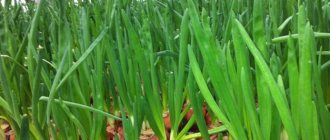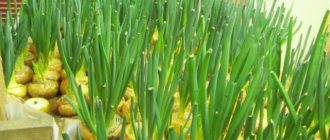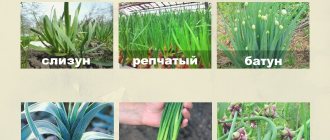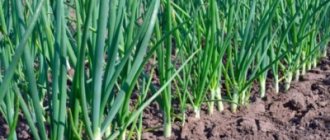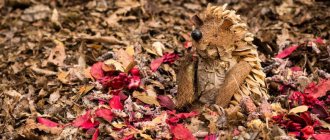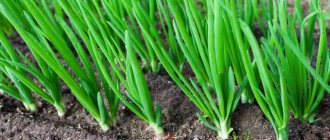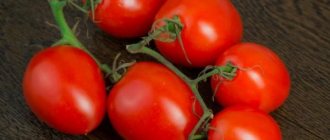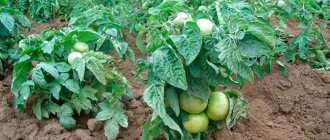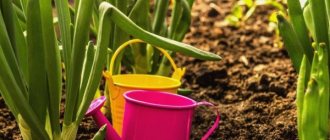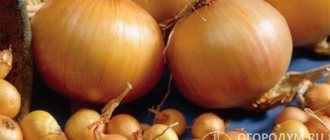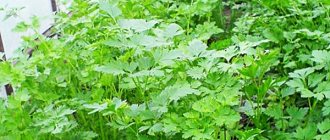Any fresh greens are especially popular in winter and spring, when gardens are still covered with snow, and not everyone has heated greenhouses. True, if we talk about forcing onions, then onion varieties are least suitable for winter, since they require more heat and light than their perennial varieties. Planting onions in the spring on greenery in a greenhouse is more justified, since it often allows you to do without additional heating and lighting and ultimately get much better results in terms of yield.
The best varieties of onions for growing in a greenhouse
To produce greens in a greenhouse, onion varieties with a large number of rudiments are selected to ensure high profitability of cultivation. Varieties with a short growing season - 90-100 days - are best suited. For spring planting, the duration of the variety's dormant period does not matter. In addition to the listed characteristics, it is important to pay attention to the quality of the pen.
Stuttgarter Risen (Stuttgart)
The well-known variety Stuttgarter Riesen from German breeders is distinguished by particularly high productivity - the yield of greens is up to 90%. One small onion produces 2-3 powerful or 4-6 medium green sprouts. The feather is juicy and tender, with a rich taste.
The “Stuttgarten Riesen” variety produces greenery up to 90% of the volume of planted onions
Bessonovsky
A popular onion variety in the middle zone. It is successfully grown for greenery in open ground and inside a greenhouse. It belongs to the multi-primordial, early-ripening varieties, producing up to 80% green mass. The feather is thick and dense, has a good presentation.
“Bessonovsky” onions are grown from seeds or sets
Chalcedony
A widespread variety that is suitable for cultivation in various regions. It has an average growing season and dormancy. Each small bulb contains 2-3 rudiments, and a large one contains 4-6. The yield of green mass is 50% and 70%. Chalcedony's feathers are powerful and juicy, have a rich color and a pronounced taste.
The "Chalcedony" variety has a pungent taste of the heads
Karatalsky
A highly rated variety for greenhouses by professionals. It is characterized by a short dormant period, early ripening and multiple buds (3-7 buds). Gives a bountiful harvest of greenery (70%) even in conditions of lack of moisture and insufficient soil fertility. The feather is strong, juicy and tender, with a good medium-hot taste.
Variety “Karatalsky” is early ripening, unpretentious in care, excellent for winter storage
Rostov local
The number of primordia is more than 3, the dormant period is average. When planting bulbs larger than 5 cm and proper feeding, a significant amount of greenery is obtained - 60-75%. Characterized by fast distillation and sharp pungency in taste. The feather is bright green, powerful and juicy.
The feather of the “Rostov local” onion quickly increases in height
Properties of green onions - harm and benefit
Medicinal properties of onions
As we have already written, green onions, due to the vitamins, micro- and macroelements they contain, help a person cope with spring vitamin deficiency. It is used as a general tonic for respiratory diseases. The phytoncides contained in its composition in large quantities cleanse not only the human body of viruses and bacteria, but also the room in which onions are grown.
The chlorophyll contained in green onions, in combination with other beneficial substances that make up the onion, promotes the process of hematopoiesis, which is why onion greens are so useful for those suffering from anemia.
Planting and caring for onions in open ground
Onion greens are also rich in essential oils, which effectively destroy infections and viruses such as the causative agents of tuberculosis, dysentery, sore throat and diphtheria. Oils disinfect the oral cavity and stimulate the activity of the heart muscle.
The composition of onion greens includes zinc, nitrogen, calcium, potassium, phosphorus and magnesium, the lack of which can cause hair loss and peeling nail plates. In addition, green onions contain the following vitamins:
- A – beta-carotene, a powerful antioxidant responsible for the quality of vision, nails, hair and skin, ensuring the functioning of the heart muscle and helping the body resist the harmful effects of free radicals;
- B1 – thiamine, necessary for the regulation of protein, fat and carbohydrate metabolism;
- B2 – riboflavin, which neutralizes toxins that irritate the respiratory tract, is involved in the formation of red blood cells and helps maintain reproductive function at the proper level;
- B3 – either nicotinic acid, or vitamin PP, or niacin, which supports the body’s immunity, promotes the breakdown of proteins, fats and carbohydrates and cleanses the body of excess cholesterol;
- B9 – folic acid, which is involved in protein synthesis and contributes to the regulation of the nervous system;
- C – ascorbic acid, a powerful antioxidant, a biologically active substance that participates in the process of hormone synthesis and increases the body’s resistance to bacteria and viruses;
- E – tocopherol, which is responsible for fertility, youth, the condition of the skin, nails and hair, giving them elasticity and responsible for the quality of functioning of the female and male reproductive organs.
Green onions - contraindications
It is not recommended to consume green onions raw for people suffering from gastritis with high acidity and peptic ulcers of the digestive system. Excessive consumption of green onions can harm hypertensive patients, since the product tends to increase blood pressure. People with bronchial asthma and diseases of the cardiovascular system should give up green onions at least during the period of exacerbation of the disease.
When can you plant onions in a greenhouse?
Planting early onions in a greenhouse at the end of winter or early spring is possible only if there is a heating system. At temperatures below 10 °C, the crop grows poorly and is often affected by fungal diseases. In view of this, onions are planted in an unheated greenhouse or greenhouse after the snow has completely melted. For the middle zone this is April.
Too short daylight hours in the first half of the growing season are compensated by artificial lighting. Otherwise, the feathers will be thin and pale, and the harvest volume will be critically low.
Which greenhouse is best to plant in?
Greenhouse conditions are considered optimal for achieving rapid and healthy plant growth. Since in these conditions it is possible to create constant temperature, humidity and light.
Greenhouses can be made from different materials. Glass, polycarbonate, and film are also suitable. It all depends on the quality of the soil, the function of the structure, etc. The most important thing that needs to be taken into account when building a greenhouse or greenhouse is that in autumn, winter and early spring it must be sufficiently lit and heated. These are two main factors that affect the final yield of the planted crop.
Many gardeners prefer polycarbonate coating. It retains heat better than glass, and is stronger and thicker than film, but is transparent enough to transmit light well.
The shape of the greenhouse plays a significant role for growing onions. In cold weather, snow covers the greenhouse, thereby preventing sufficient lighting.
In this case, you need to switch either to artificial light or remove the snow cover in a timely manner. Snow does not stay on gable and round roofs.
The greenhouse frame can be anything, but when using them you need to perform some steps. Thus, a wooden frame needs periodic painting, antiseptic treatment, and primer. Otherwise, the base will deform and rot.
A metal frame is most often used, as it is stronger and stiffer than a wooden one. But even in this case, care is necessary: to avoid corrosion, the product must be periodically painted or primed.
How to grow onions for greens in a greenhouse
To obtain high-quality onion feathers, suitable conditions must be created in the greenhouse:
- temperature - 10-25 oC;
- humidity - 70-80%;
- regular watering;
- frequent ventilation;
- daylight hours - at least 12 hours.
Important!
The higher the temperature in the greenhouse, the faster the feather grows. Green feathers are obtained through second year bulbs, large sets and seeds. The first method is the most common and simplest. But for high profitability, you need to correctly select and prepare planting material. Forcing feathers from onion sets is a simple process, but the greens become thin. Obtaining feathers from seeds in a greenhouse is the most difficult approach, which is not used on an industrial scale.
Bulbs
To obtain greens, they usually choose well-preserved bulbs, the diameter of which does not exceed 3-4 cm. Sometimes larger turnips (5-6 cm) are used, but in this case the yield growth decreases, and the planting itself takes up a lot of space. Single-bud bulbs produce 30% of the planting material’s greenery mass, multi-bud bulbs – up to 90%.
Planting bulbs is carried out in several stages:
- Stimulation. In order for the bulb to finally wake up and begin to grow, the top of it is cut off up to the shoulders. Additionally, you can make shallow vertical cuts in the neck.
- Land preparation. The area of the greenhouse allocated for onions must be thoroughly moistened before planting.
- Landing. To obtain greenery in a greenhouse, onions are usually planted in a bridge method - they are laid tightly next to each other. The turnips are not deepened, but only slightly pressed to the ground. The top is lightly sprinkled with wet peat or humus.
Advice! Soaking the bulbs in a solution of copper sulfate before planting helps increase the volume and usefulness of feathers.
How to plant onion sets on greens in a greenhouse
To grow greens in a greenhouse, select large onion sets - 1.5-2 cm. To “peck” the sprouts faster, the tops need to be cut off. To speed up germination, it is also practiced to immerse the selected seeds in warm water for a day. In this case, the greens “hatch” 4-5 days earlier.
Most often, feathers are grown through onion sets for sale. With good lighting and fertilizing, the output is an impressive amount of greenery. It is planted tightly, slightly buried in the ground. Sprinkle a little moistened soil on top. To continuously obtain greenery, planting is done every two weeks.
Seeds
From seeds (nigella) they mainly practice forcing greens for personal consumption. The highest rates of germination are achieved by grains that have been stored for no more than two years. Before sowing, nigella is checked by placing a small amount in a wet cloth. If at least 80% of the seeds hatch, they are suitable for growing feathers.
Seeds are prepared for planting in this way:
- Soak in warm water for 24 hours (change the liquid 3 times).
- Immerse for an hour in a solution of potassium permanganate.
- Keep the antifungal drug in liquid form for 10-12 hours.
The nigella is dried and sown to a depth of 1.2-1.5 cm (the heavier the soil, the smaller the depression). A distance of 1.5 cm is maintained between the rows. The sowing density is calculated as follows: 2 g of seeds are consumed per 1 m.
Advice! If you pre-mix nigella with chalk, the sowing will be more uniform.
The sprouts that “hatch” from the ground are thinned out, leaving 2 cm between them. When 2-3 leaves are formed, the row is broken through, leaving 3-5 cm between adjacent sprouts.
Greenhouse equipment
A greenhouse for forcing onions made of polycarbonate or any other material must be equipped with all the necessary equipment. It is extremely important to take care of the availability of shelving, lighting, irrigation and heating systems. With their help, growing a large amount of greenery will not be difficult.
Racks and containers for planting
It is very convenient to plant onions before winter in a greenhouse on racks with several tiers. In this way it will be possible to significantly increase the yield.
The width of the structures is about 35 cm. Containers for the bulbs are selected of the appropriate size. The soil in them will warm up faster, and due to this, the feather will begin to germinate much earlier. In addition, caring for plants will be much easier. When placing them on racks, there will be no need to constantly bend over to the beds.
Lighting
As a rule, fluorescent lamps with a power of up to 60 W are used, but if desired, they can be replaced with LED or strips. The distance from one lighting fixture to another should be 1.2 m.
Irrigation and heating systems
Only with timely watering of onions will it be possible to grow a lot of greenery. In this case, warm water that has settled in barrels is used. The soil needs to be moistened systematically. A drip irrigation system can simplify this task.
It will be possible to maintain the temperature within normal limits using heating devices. For this purpose, gas or electric boilers are used. Pipes are located around the perimeter of all greenhouses. Stove heating is also suitable for heating. The use of electric heaters is allowed.
Top dressing
Experienced agronomists annually fertilize the soil in the greenhouse in the fall. Therefore, there is no need to apply additional fertilizer to the onions. If pale and thin feathers are formed, you can spray with a solution of urea or another suitable preparation. At the end of the procedure, the greens are doused with clean water.
Thin and pale onions in the greenhouse need to be fed
When growing feathers for sale, greenhouse owners strive to get the harvest as quickly as possible. To do this, they carry out 2 or 3 feedings. At the beginning of the growing season, nitrogen and potassium are added. Before harvesting onions, “Gumisol”, “Vermistil” and other complex preparations are used.
What types of onions are there?
There are several types of onions that have their own growing characteristics. Let's take a closer look:
- Leek.
- Shallot.
- Batun.
- Schnitt.
Each type of onion has a specific approach and growing technology.
Leek
Features of growing leeks
This variety is grown from seeds and is especially valued for its delicate aroma and excellent taste. Both the greens and the white part of the variety are used for food. Planting instructions:
- Before planting the crop, the seeds are pre-soaked and planted in small pots that are 2/3 filled with soil.
- The seeds, covered with soil, are covered with plastic wrap and placed in a warm place.
- The seedlings are watered every three days (the bag is removed and then put on again). When the crop germinates, the bag is removed and the seedlings are placed on the windowsill.
Note. Before transferring onions to the greenhouse, it is necessary to fertilize the soil well with ash and humus.
- The plant is planted one at a time at a distance of 100 mm from each other. In dry weather, the onions are watered and soaked.
In order to get a long white leg at the finish, it is recommended to make special grooves in the soil. The seedlings need to be planted at the very bottom, and add soil as they grow.
Drought tolerant shallot plant
Photo of shallots
This variety has an excellent aroma and pungent taste. The base resembles garlic.Features of the culture:
- The crop propagates vegetatively and has a very high yield; the price of the crop is not high.
- When onions are planted, they are divided into several parts (3-8).
- Since the culture is growing rapidly, the distance between them should be no more than 16 cm.
Planting is done in autumn and spring, and ripens much faster than regular onions.
Batun
It is recommended to grow it in a heated greenhouse, even in winter, since the crop is not demanding on the length of the day. Features and characteristics:
- Forcing onions will take about 26 days if done in November.
- In winter, from 14 (February) to 20 days (January).
The culture requires frequent watering. The greens are even, which distinguishes them from ordinary onions, and the cost is much lower.
Chives
Features of culture
The crop reproduces by thickening the rhizome, which is why it appears in large quantities during the growing season, so obtaining planting material is not a problem.
Peculiarities:
- In late autumn, the material is dug up and left for about three weeks. After which the onions are ready for planting in the greenhouse.
- In order for it to begin to germinate intensively, the culture is watered with warm water (temperature from 35 to 40 degrees).
- The soil thickness must be at least 100 mm and does not need to be fertilized.
- When the onions begin to sprout, it is necessary to maintain a temperature of 20 to 22 degrees.
Advice. When the feather is formed, the temperature climate should be maintained between 16 and 18 degrees. But in order for a feather to be beautiful there must be a lot of light.
- Watering is carried out regularly in small portions; soil moisture should not exceed 80 degrees.
Attention! Too high humidity can negatively affect the quality of feathers.
Growing onions is not a difficult task; you just need to fully follow the technology.
Diseases and pests
The combination of high humidity and low temperatures in a greenhouse often leads to fungal diseases. They appear as spots of varying colors and areas of rot on the lower or upper half of the onion. The most common pests are onion fly, stem nematode and secretive proboscis.
Disease and pest control is carried out primarily through prevention. Effective methods are annual soil replacement in the greenhouse and fruit rotation. Wood ash is effective against onion flies. If the use of insecticides or fungicides is necessary, biological compounds are chosen. They decompose in just a few days, after which the onions can be safely eaten.
Planting and growing
When planting onions, you should consider its variety. In some cases, it is more preferable to cultivate by seed. But other varieties are planted by selecting seedlings. It is necessary to check that the soil is moist. But under no circumstances should overflow be allowed. In this case, the bulbs will begin to rot.
It is advisable to plant the bulbs in rows, this will make it easier to care for them. You can sit next to each other. It is better not to use pure black soil for growing this crop. It is much better if the soil is sandy. But it is advisable to fertilize it, if not with peat, then at least with ready-made humus. It is important to remember that this plant loves light and warmth, but elevated temperatures are dangerous for it.
Look what crops gardeners from northern Asia managed to grow in a greenhouse in winter.
Harvesting
The harvest period depends on the onion variety and the conditions created in the greenhouse. Usually it takes 4 to 6 weeks after planting until this point. Leaves 25-40 cm long (from ground level) are ready for sale and consumption. Greens of 50 cm are considered non-commercial.
Cleaning is carried out in the following way:
- The onion is cut at the root with a knife.
- Cut off the bottom.
- Hold the onion with one hand, and pull out the feather with the other.
- Remove the transparent film from the white part.
- Packed in newspaper or cellophane.
Commercial length of green onions is 25-40 cm
Planting onions by month
Beginning in April, summer residents prepare beds for onions; for forcing the feathers, they use multi-primed varieties of onions:
- Cipoluccio.
- Aristocratic.
- Lilac ringing.
- Stuttgarten Risen.
You can determine which varieties have multiple buds by cutting the bulb; the best are considered to be those with 4–6 buds. In terms of productivity, Stuttgarten Riesen is a good variety; when planted on a bridge, up to 15 kg of high-quality greenery is obtained from 1 m². For sale, onions are grown in heated greenhouses throughout the year; in unheated buildings, onions are planted on greens from early spring to late autumn.
Technological features of growing crops
For planting, you will need to choose exactly those varieties that will allow you to get an excellent harvest. Today, the Troitsky and Spassky varieties are especially popular. How to grow onions in winter, recommendation:
- In order for the greens to be of high quality, it is necessary to provide lighting for 12 hours a day, after the second forcing.
- It is not recommended to use bulbs that are too small for planting. Then the feather does not sprout quite beautifully.
Features of growing onions in the basement:
- For basement growing, regular shelving is quite suitable. This will allow you to use the maximum usable area of the room.
Share on social networks
